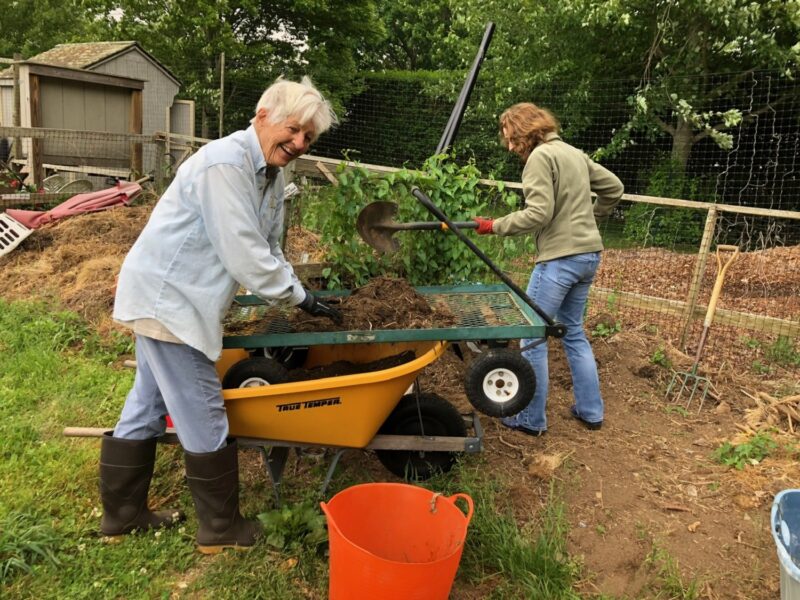

“Gardening is a way of showing that you believe in tomorrow” — Audrey Hepburn
When I first joined a community garden and fellow gardener Cindy Warne told me she’d googled, “Is eating too many cherry tomatoes bad for you?” I thought she was, well, a teeny bit insane.
But I was new to the Good Shepherd Farm in Bridgehampton and that was months before I tasted my first cherry tomato. I was so naive. The problem with these little candy-sweet tomatoes is that they’re everywhere you turn, available all summer long and highly addictive. And that was just the tomatoes.
I joined this garden, not because I was already a gardener, but because I didn’t know anything about gardening. I’d lived in cities most of my life, where even my house plants were failed crops. To me, if you had a brown thumb it meant that at least something lived long enough to turn brown. The learning curve was high.
Luckily, at a community farm you’ve got all kinds of gardeners with all kinds of knowledge, ranging from Certified Master Gardeners to newbies like me who, left to their own devices, could kill a plastic fern.
Every week, and possibly just through osmosis, I’m learning something new. Not just about gardening, but about plants I hardly knew existed. I learned how to cook with lemon grass and lavender thyme. I discovered that throwing lovage or sorrel in a salad would spice it up. It seems that just about everything can make a medicinal tea — cat nip, feverfew and something called horehound that helps with loss of appetite. And lo and behold — stevia is more than just a little green package of sweetener offered in health food stores.
Whether joining a community garden, farm CSA (Community Supported Agriculture), or growing spices at home, gardening offers the perfect combination of everything that’s good for us: healthy food, exercise, improved mental health and supporting a healthier environment. Plus, you save money, which is very good for one’s health.
Gardening has taught me to eat what’s in season, rather than running around hunting down a kiwi just because I’m in the mood for it. Luckily on the East End, the seasons are long, stretching from June through October. November, if you count the garlic, onions, leeks, pumpkin, squash and sweet potatoes. A few years ago, I’d never heard of a Jerusalem artichoke. Now I’m picking them in December. The season is extended even further if you’re freezing tomato and pesto sauce and drying sage, dill, parsley and chives.
Food grown locally makes a big difference helping mitigate global warming and improving the local environment.
Locally grown produce reduces “carbon miles,” the distance from the farm to your table. On average, food in the U.S. travels over 1,000 miles to get to our store shelves. The fossil fuel consumed for this long distance haul is responsible for up to 17 times more CO2 emissions than locally grown food. Organic gardens that are close to home create almost zero carbon emissions and even function as a carbon sink, drawing carbon back into the soil.
Truly climate-friendly food is grown without synthetic fertilizer, chemical pesticides and herbicides, which destroy the soil’s ecosystem and contaminate our drinking water. Community gardens and CSAs typically find natural ways to control weeds and pests. At our farm, rather than using insecticides, we take a preventative approach, encouraging good bugs like praying mantis, who eat the “bad” bugs. Rather than using synthetic fertilizer, we compost to return nutrients back to the soil.
In an age where so many natural habitats have been bulldozed to build homes, gardens give birds, bees, butterflies and other wildlife a refuge and a chemical-free food source.
Then there’s the flavor factor. A cherry tomato that comes from California is often genetically modified to travel better. It might be “engineered” for thicker skin and to be less juicy so it doesn’t crush easily. Usually it’s picked long before it’s ripe, so it never reaches its full flavor.
Or it’s injected with chemicals to prolong its life. As food is transported, what little nutritional value it had to begin with begins to degrade. By the time we get this Frankenfood, it’s basically cardboard disguised as a tomato.
Gardening is an underrated form of exercise. The American Heart Association may classify it as “moderate exercise,” but when I’m shoveling heavy compost in the heat, I’d beg to differ. Gardening helps improve muscle strength, endurance and mobility. Digging in the dirt can even help enhance bone density as one study by the University of Arkansas revealed.
In terms of long-term health, gardening lowers blood pressure and cholesterol, and reduces the risk of developing diabetes, heart disease, and other chronic illnesses.
Beyond the physical benefits, gardening improves mental health. An article in the Journal of Environmental Horticulture outlines the numerous psychological benefits of gardening: It increases creativity and productivity, decreases depression and mitigates effects of PTSD. Breaking up your work day to get into the garden has also been shown to improves concentration and memory. It can also help reduce the effects of dementia.
Even the dirt itself has powerful mood-enhancing microbes. Putting your hands in the soil releases a feel-good bacterium called Mycobacterium vaccae that can trigger the release of serotonin in the brain and ground the nervous system. According to the National Library of Medicine, “Some soil microbes have effects comparable to Prozac.”
Whatever the neuropsychological data reveals, I’ve heard people in our garden call it their “happy place.”
For me, there are benefits that seem too intangible to be quantified in medical studies. Maybe it’s the pride of looking at my salad and knowing I grew everything in it myself. Or the Zen of focusing on what I’m doing long enough to forget the outside world. It could be the olfactory pleasure of deadheading basil or weeding around fennel plants. Or leaving the garden with stained yellow fingers smelling like one of those high end tomato scented candles. That’s the time when all is good with the world.
The cha-ching factor is enormous. Considering the $10 quart of cherry tomatoes offered at most Hamptons farm stands, community farms and CSAs are a bargain. At community gardens, we pay in hours “worked” in exchange for an abundance of produce. Not to mention what a big bouquet of fresh flowers would cost every week.
If working in a community garden feels like a huge time commitment, joining a CSA at a sustainably minded farm is a good way to eat healthy and support local farmers. Because your weekly box of seasonal food will always be a surprise, you learn to get creative in the kitchen. And while you don’t do the down and dirty part of gardening, CSAs like Amber Waves, Quail Hill and Sylvester Manor let you pick your own veggies, herbs and flowers.
Toward the end of the season, I started to worry that I myself had a cherry tomato problem. When I Googled, ‘Is it dangerous to eat too many cherry tomatoes?’ Dr. Google informed me that the insatiable craving for tomatoes is called tomatopheglia and that there can be a problem with overdosing on lycopene. Still, there are worse addictions. It’s almost sweet pea season.
More Information:
Amber Waves Farm (amberwavesfarm.org): CSA program in Amagansett with pick-your-own program. Offers a wide variety of vegetables, grain, herbs and flowers. Known as a teaching farm, they offer many workshops and classes. Join the Fundraising Hoedown August 18.
Quail Hill Farm (peconiclandtrust.org): CSA program on a 35 acre farm in Amagansett with pick-your-own program twice weekly. Offers a variety of fruits, vegetables, herbs and flowers. Stop by the annual plant sale and CSA open house on May 25.
Sylvester Manor (sylvestermanor.org): CSA program on Shelter Island with pick-your-own program. Offers a variety of herbs, berries, vegetables and flowers on your pick up day. Also offers an egg share program. Join the Farm to Table benefit June 29.
Good Shepherd Farm: All volunteer community farm in Bridgehampton that harvests a wide variety of herbs, vegetables and flowers. Four hours of work per week required. Flexible schedule. For more information call 631-786-2293.
EECO Farm (EECOFarm.org): Community garden plots available for rent. While most community gardens and CSAs donate to food pantries, the EECO Farm stand (managed by Share the Harvest Farm) donates 80 percent of what’s sold to local families in need. Volunteers welcome. Join the Annual Festival in the Fields Fundraiser in early August.
 More Posts from Jenny Noble
More Posts from Jenny Noble